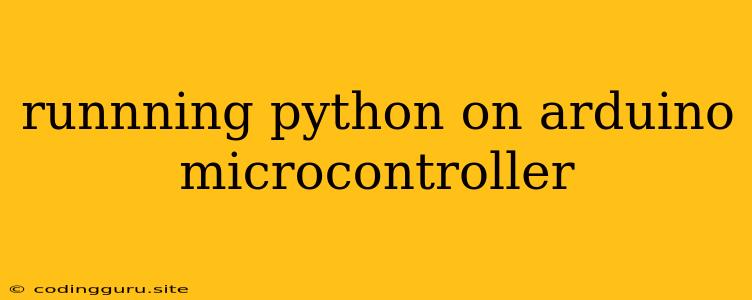Running Python on Arduino Microcontrollers: Bridging the Gap
The Arduino platform, known for its ease of use and versatility, has traditionally been associated with C++ programming. However, with the rise of Python's popularity, the desire to harness its power and simplicity within the Arduino environment has grown. This article explores the methods and tools that allow you to run Python on Arduino microcontrollers, empowering you to build innovative projects with a more intuitive and expressive language.
Why Choose Python for Arduino?
Python's popularity stems from its readability, conciseness, and extensive library support. Compared to C++, Python code is often shorter, making it easier to write, debug, and maintain. Its vast ecosystem of libraries provides readily available tools for a wide range of tasks, including data analysis, machine learning, and web development.
Bringing these advantages to the Arduino world opens up exciting possibilities:
- Rapid prototyping: Python's concise syntax allows for faster development cycles, making it ideal for experimenting with new ideas.
- Simplified code: Complex logic can be implemented with fewer lines of code, enhancing readability and maintainability.
- Access to rich libraries: Python's vast library ecosystem enables you to integrate functionality like networking, image processing, and data visualization directly into your Arduino projects.
Running Python on Arduino: The Options
Several approaches enable you to run Python on Arduino microcontrollers. Each comes with its own advantages and limitations:
1. MicroPython:
This is a Python implementation specifically designed for microcontrollers. It offers a subset of the standard Python language, optimized for resource-constrained devices. MicroPython can be flashed directly onto supported Arduino boards, allowing you to interact with them using a Python interpreter.
2. CircuitPython:
CircuitPython is a variant of MicroPython tailored for use with Adafruit's boards. It focuses on ease of use, providing a streamlined experience for beginners. CircuitPython provides a comprehensive set of libraries for common tasks, making it a popular choice for hobbyists and educators.
3. Python-based frameworks:
Frameworks like Micropython-Arduino, PyMite, and Arduino-Python-Interpreter provide a bridge between Python and Arduino. These frameworks typically require you to install a Python interpreter on your computer and communicate with the Arduino board over a serial connection.
Setting up your Arduino for Python
The process of setting up your Arduino for Python execution depends on the method you choose:
-
MicroPython/CircuitPython: You'll need to download the appropriate firmware image for your Arduino board and flash it onto the microcontroller. This process can be achieved using tools like the MicroPython Downloader or the CircuitPython Loader.
-
Python-based frameworks: These frameworks typically involve installing a Python interpreter on your computer and configuring the communication between your computer and the Arduino board.
Example Code (MicroPython):
from machine import Pin
led = Pin(25, Pin.OUT)
while True:
led.value(1)
time.sleep(0.5)
led.value(0)
time.sleep(0.5)
This code demonstrates controlling an LED connected to pin 25 of an Arduino board using MicroPython.
Example Code (CircuitPython):
import time
import board
import digitalio
led = digitalio.DigitalInOut(board.LED)
led.direction = digitalio.Direction.OUTPUT
while True:
led.value = True
time.sleep(0.5)
led.value = False
time.sleep(0.5)
This CircuitPython code achieves the same LED control functionality as the MicroPython example.
Considerations and Limitations
While running Python on Arduino offers exciting possibilities, there are some limitations to keep in mind:
-
Memory and processing power: Microcontrollers have limited resources compared to traditional computers. Python code can be more memory-intensive, so you might encounter limitations on resource-constrained boards.
-
Real-time performance: Python is generally slower than C++. If your project requires real-time responsiveness, C++ might be a better choice.
-
Library availability: Although Python has a rich ecosystem, some libraries might not be available for use on Arduino.
Conclusion
Running Python on Arduino microcontrollers opens up a new world of possibilities for makers and hobbyists. By leveraging Python's simplicity and powerful libraries, you can build more sophisticated projects with ease. While some considerations regarding resource constraints and library availability should be kept in mind, the benefits of Python's accessibility and ease of use make it a compelling choice for Arduino development.
